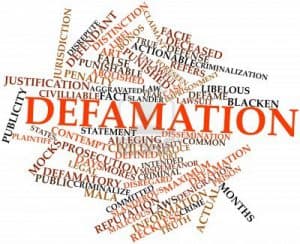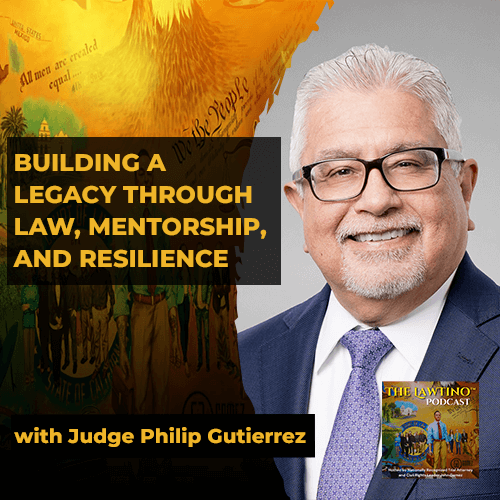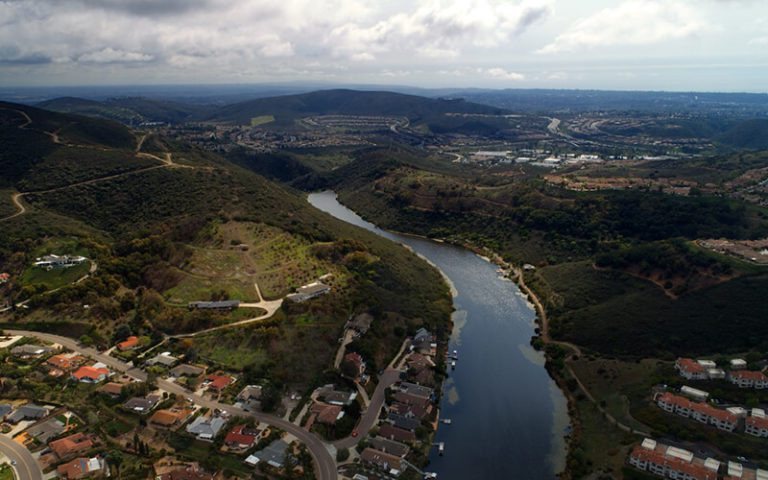By John Gomez and Bibi Fell
[profileleft] [/profileleft]Defamation law is “…a forest of complexities, overgrown with anomalies, inconsistencies, and perverse rigidities.” McNair v. Worldwide Church of God (1987) 197 Cal.App.3d 363, 375. Consumer attorneys often shy away from these cases rather than diving into the defamation abyss for fear of coming upon one of these “perverse rigidities.” However, these cases can be righteous, and important to the fabric of our judicial system.
[/profileleft]Defamation law is “…a forest of complexities, overgrown with anomalies, inconsistencies, and perverse rigidities.” McNair v. Worldwide Church of God (1987) 197 Cal.App.3d 363, 375. Consumer attorneys often shy away from these cases rather than diving into the defamation abyss for fear of coming upon one of these “perverse rigidities.” However, these cases can be righteous, and important to the fabric of our judicial system.
The purpose of this article is not intended as a definitive guide on defamation claims, but solely a primer on some common issues that may arise during your defamation case.
Defamation in California
California has codified defamation in §§44-48 of the Civil Code, but the right to redress for harm to one’s reputation is a long-standing right passed down through centuries of common law. McNair, supra, at 374-375; see also Rosenblatt v. Baer (1966) 383 U.S. 75, 92 (conc. Opn. Of Stewart, J.) (“The right of a man to the protection of his own reputation…reflects no more than our basic concept of the essential dignity and worth of every human being – a concept at the root of any decent system of ordered liberty.”)
Today, the ubiquity of internet sites such as Yelp, Ripoff Report, Angie’s List, Google Reviews and Facebook have made it easier than ever to publish libelous statements, some under a cloak of seeming-anonymity.
Defamation is effected by either libel or slander. Civ. Code. §44. It requires 1) publication that is, 2) false, 3) defamatory, and 4) unprivileged, that 5) has a natural tendency to injure or that causes special damage. Wong v. Jing (2010) 189 Cal.App.4th 1354, 1369; see also Judicial Council of California Civil Jury Instructions (2015 Edition), CACI Nos. 1700-1707.
In order to recover in a defamation claim the Plaintiff also must show that the statement was made as a “fact” and not an “opinion,” a determination which should be left to the trier of fact, so long as the Court concludes that a statement could reasonably be construed as implying a false assertion of fact. Campanelli v. Regents of Univ. of Cal. (1996) 44 Cal.App.4th 572, 578; see also Hawran v. Hixon (2012) 209 Cal.App.4th 256, 289.
Different standards apply both in pleading and proving defamation claims depending whether the false statements were made 1) about private persons, 2) about public figures and/or issues of public concern, or 3) in the employment setting.
Defamation, You Say? Per Se?
Where the defamatory meaning of a statement is clear without the need for explanation, it is considered “defamation per se.” Contento v. Mitchell (1972) 28 Cal.App.3d 356, 358. When these statements are published by “writing, printing, picture, effigy, or other fixed representation to the eye” they are said to be “libel per se” and do not require proof of special damages. Cal. Civ. Code §§45-45(a); 5 Witkin, Summary of Cal. Law (10th ed. 2005) Torts, §529, §541. Only certain types of oral statements (slander) are presumed to be defamatory. Civ. Code §46.
Alleged defamatory statements that are not clearly defamatory on their face require plaintiff to prove special damages. Civ. Code §45a; see also Sullivan v. Warner Bros. Theatres (1941) 42 Cal.App.2d 660. These types of defamation are said to be “defamation per quod.”
Publication
Publication means that the defamatory matter must be communicated to some third party who understands its defamatory meaning and application to the plaintiff. Ringler Associates v. Maryland Cas. Co. (2000) 80 Cal.App. 4th 1165, 1175. In order to prove publication, Plaintiff need only show the defamatory statement was communicated to a single individual. Smith v. Maldonado (1999) 72 Cal.App.4th 637, 645. Publication need not be intentional — a negligent communication of a defamatory statement is sufficient. Hellar v. Bianco (1952) 111 Cal.App.2d 424, 426.
The plaintiff’s testimony of knowledge of publication is sufficient to prove that the statement was published. Cunningham v. Simpson (1969) 1 Cal.3d 301, 307. Likewise, it is well-establish that that publication may be proven by hearsay. People v. Henry (1948) 84 Cal.App.2d 785, 789.
Finally, each publication of the defamatory statement gives rise to a new cause of action for defamation. Shiveley v. Bozanich (2003) 31 Cal.App.4th 1230, 1242. Anyone who takes a “responsible part” of the publication, or republication, may be liable for defamation. Hawran, supra, at 275-276. The original defamer is responsible for each and every foreseeable “republication.” Schneider v. United Airlines (1989) 208 Cal.App.3d 71, 75.
This point is particularly important in defamation claims because each new publication begins a new statute of limitations. Each republication gives rise to a claim for damages attributable to that republication.
Truth as a Defense
In matters involving private plaintiffs and matters of private concern, the defendant bears the burden to plead and prove the defense of truth. Lipman v. Brisbane Elementary School Dist. (1961), 55 Cal.2d. 224, 233; 5 Cal. Proc. (4th), Pleading, §694.) In these cases, truth is a defense. Moyer v. Amador Valley Joint Union High school District (1990) 225 Cal. App.3d 720, 724.
Keep in mind that when a defendant pleads truth as a defense this may actually help your case and propel you towards punitive damages. Specifically, when truth is plead as a defense, and the statement’s falsity is proven at trial, an inference of malice can be properly drawn by the jury. Shumate v. Johnson Publishing Co. (1956) 139 Cal.App.2d 121, 138, (“There is always a certain risk involved in the pleading of truth as a defense, since in proper cases and under proper instructions the jury may infer malice from the fact that defendant repeats the defamatory matter, which is later found to be false.)
Where the Plaintiff is a public figure or the statement published includes a matter of public concern, the plaintiff holds the burden to prove the statement was false. Nizam-Aldine v. City of Oakland (1996) 47 Cal.App.4th 364, 373; Brown v. Kelly Broadcasting Co. (1989) 48 Cal.3d 711, 747.
Are You “Absolutely” Sure That is Privileged?
There are two types of privilege in defamation which are often confused by plaintiffs and defendants alike: absolute privilege and conditional privilege.
Most basically, absolute privilege is based on the “necessity of complete protection from the threat of a civil action.” 5 Witkin, Summary of Cal. Law (10th ed. 2005) Torts, 529, 561. When a publication is made and absolute privilege is established, there is no liability even if it was made with actual malice. Id.; see also Gosewich v. Doran (1911) 161 C. 511, 514. Publications that are absolutely privileged are listed in Civil Code section 47. For example, a false statement made in a court filing is subject to the absolute privilege. The practitioner should be aware that courts have broadly construed the Civil Code section 47 privilege. See e.g. Rubin v. Green (1993) 4 Cal.App.4th 1187, 1193.
Conversely, a statement is qualifiedly, or conditionally privileged, when the communication is made, without malice to a person interested therein, (1) by one who is also interested, or (2) by one who stands in such a relation to the person interested as to afford a reasonable ground for supposing the motive for the communication to be innocent, or (3) who is requested by the person interested to give the information. Civ. Code §47(c). The Defendant bears the initial burden to demonstrate the communication was privileged. Taus v. Loftus (2007) 40 Cal. 4th 683, 721.
Qualified privilege will most commonly be argued in the employment setting. However the following situations have been found to constitute a showing of a qualified privilege: an administrative agency in performing a statutory duty to record and disseminate information from authorized persons (White v. California (1971) 17 Cal.App.3d 621, 628.), an employer communicating to his or her employees (Dealie v. General Tel. Co. of Calif. (1974) 40 Cal.App.3d 841.), a telegraph company transmitting messages from one sender to another (Mason v. Western Union Tel. Co. (1975) 52 Cal.App.3d 429, 436.), a person who makes a complaint to a local bar association of allegedly unethical conduct of an attorney (Katz v. Rosen (1975) 48 Cal. App.3d 1032.), a complaint by parents to the principal of a school alleging misconduct by a teacher (Martin v. Kearney (1975) 51 Cal. App.3d 309, 311 [held to be both absolutely and qualifiedly privileged].), statements by the president of a company to insurance adjusters who refer business to the company regarding a former employee and the reasons for his termination (Williams v. Taylor (1982) 129 Cal.App.3d 745, 752.), an employee’s letter to the human resources department charging her manager with sexual harassment. (Cruey v. Gannett Co. (1998) 64 Cal.App.4th 356, 368.). 5 Witkin, Summary of Cal. Law (10th ed. 2005) Torts, §529, §594.)
A qualified privilege, unlike an absolute privilege, is lost when the privilege is abused, or the plaintiff can demonstrate malice. Deaile, supra, at 847. Whether the defendant acted with malice is a question of fact for the jury. Agarwal v. Johnson (1979) 25 Cal. 3d 932, 944-945. Malice for the purpose of showing an abuse of the qualified privilege only requires showing of a state of mind arising from hatred or ill will evidencing a willingness “to vex, harass, annoy or injure.” Burnett v. Nat. Enquirer, Inc. (1983) 144 Cal.App.3d 991, 1009; see also Frommoethelydo v. Fire Ins. Exchange (1986) 42 Cal.App.3d 208, 228.
The following are just a few situations that have been sufficient for a showing of malice: where there was a failure to investigate and verify thoroughly the facts published (Widener v. Pacific Gas & Electric Co. (1977) 75 Cal.App.3d 415, 434-35.), where the publisher lacked reasonable grounds for belief in the truth of the publication (MacLeod v. Tribune Publishing Co. (1959) 52 Cal.2d 536, 552.), where the publication was made with a reckless disregard for the plaintiff’s rights (Stationers Corp. v. Du & Bradstreet, Inc. (1965) 62 Cal.2d 412, 428.), in the employment setting, where policy to maintain privacy of personnel matters is violated by disseminating the information “beyond the group of interest.” (Emde v. San Joaquin County Etc. Council (1943) 23 Cal.2d 146, 154-155.)
Defamation in the Employment Setting
It is well-settled that defamation cases do not fall within the workers’ compensation exclusivity rule. Howland v. Balma (1983) 143 Cal.App.3d 899, 904 [“the harm flowing therefrom is not a personal injury’ (i.e. medical or physical injury to the body) or a risk of employment within the purview of the workers’ compensation law.”]; see also Shoemaker v, Myers (1990) 52 Cal.App.3d 1, 16.
In the employment setting internal publication (within the company) of the defamatory statement is sufficient. Agarwal, supra, at 944.
However, because most employment situations include situations involving a “common interest,” a conditional privilege will often apply and malice or abuse of the privilege will likely need to be demonstrated.
Don’t Fear Getting Anti-SLAPPed
The original purpose of California’s Anti-SLAPP legislation was to “encourage continued participation in matters of public significance,” and to prevent the “abuse of the judicial process” by the filing of Strategic Lawsuits Against Public Participation (SLAPP). Kathryn W. Tate, California’s Anti-Slapp Legislation: A Summary of and Commentary on Its Operation and Scope, 33 Loy. L.A. L. Rev. 801 (2000). Thus a special motion to strike based on the Anti-SLAPP statute should only be brought and granted in those situations where Plaintiff is filing a frivolous suit that would have some quelling effect on public participation. Instead, Defendants tend to file these special motions in nearly every case in which a Plaintiff alleges defamation – and courts have construed the statute to have a broad reach.
When reviewing potential defamation cases, particularly involving private individuals and private matters, attorneys should recognize that the delays and attorney’s fees provision within Code of Civil Procedure section 425.16 can also be used in a plaintiff’s favor.
First, while the special motion to strike allowed by the statute suspends discovery upon filing, limited discovery may still be permitted if the plaintiff makes a noticed motion and shows good cause. Cal. Civ. Proc. Code §425.16(g). Since some of the elements you will need to have admissible evidence to support in order to oppose the motion will likely require information from the defendant, you should always strongly consider bringing such a motion. Since the reason for the code allowing the stalling of discovery is primarily to help the SLAPPee avoid a costly process at the beginning of the case, you will need to argue the necessity of gathering information from the other side which is solely in the defendant’s possession. You should also explore whether a stipulation of facts for purposes of the Anti-SLAPP motion only is available. If the defendant believes that the issue is one of law, the defendant may be willing to stipulate to factual elements you will need to prove in order to avoid discovery.
Second, while the statute allows for attorney’s fees and costs if the motion is granted, it simultaneously allows for attorney’s fees and costs for the plaintiff if the special motion to strike is found to be frivolous or solely intended for delay. Cal. Civ. Proc. Code §425.16(c). Since Courts are becoming more and more aware of the aimless nature with which Defendants file these motions, Plaintiffs should always request fees and costs for these frivolous motions. These arguments should be based not only of the frivolity of the motions themselves, but also on the stalling effect they have on judicial efficiency – the exact thing the statute sought to prevent. You should make clear to the Court that the purpose of §425.16 is not only to protected the alleged SLAPPee, but also the victim of a time-wasting anti-SLAPP motion. While the burden of proving frivolity is high, courts do grant these motions.
The Tricky Issue of Course and Scope
Usually an employer will argue that the individual defendant was acting without the permission of the company when he or she made the defamatory statement. Defendants will likely argue that the defamatory internet post or the internal allegation against the plaintiff was solely of the individual’s own doing and completely unrelated to any business purpose. However, these contentions, even if true, are not dispositive. If the motive is engendered by the individual’s employment, the employer may be held liable.
An employer is liable for an intentional tort of one of its employees, if the employee’s act has a “causal nexus to the employee’s work.” Lisa M. v. Henry Mayo Newhall Memorial Hospital (1995) 12 Cal.App.4th 291, 297; see also Montague v. AMN Healthcare, Inc. (2014) 223 Cal.App.4th 1515, 1521. Scope of employment in the application of the respondeat superior doctrine has been given a broad construction. Farmers Ins. Group v. County of Santa Clara (1995) 11 Cal. 4th 992, 1004; Delfino v. Agilent Technologies, Inc. (2006) 145 Cal. App.4th 790, 812-813. (holding that if the misconduct is an engendered by the employment and not solely out of personal malice the employer may be held liable.)
Defendants must demonstrate that the act was a “substantial departure” from any “foreseeable” conduct within the employment. Avila v. Standard Oil Co. (1985) 167 Cal.App. 3d 441, 448 (Minor deviations for personal or private purposes do not bring the employee outside the course and scope of employment.); see also De Mirjian v. Ideal Heating Corp. (1954) 129 Cal.App.2d 758, 766; Lazar v. Thermal Equipment Corp., (1983) 148 Cal. App.3d 458, 464.
Since many defamatory statements made by employees, even if made without explicit permission of the company, will either benefit the company itself, or are the product of a working relationship within the company, the statements will often be determined to be within the scope of employment.
If you have a question or concern regarding defamation, contact a San Diego personal injury attorney at Gomez Trial Attorneys to schedule an initial consultation.







